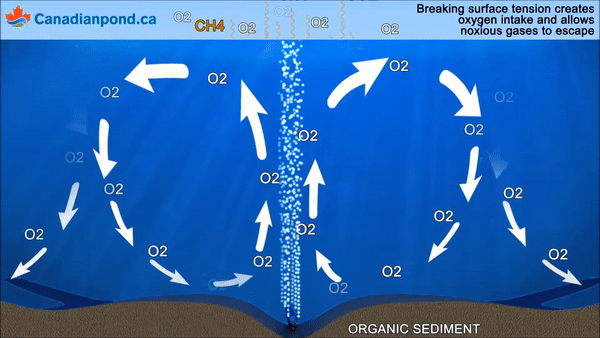
Bubbles and Water Aeration
Proper amount of aeration is essential to keeping water and its aquatic life healthy. However aeration of water is more complex than it may seem and involves a range of variables and inherent processes. Hence, our Living Lab "What is Under Your Water? Bubbles that Clean" links directly to the essence of bubble curtains. Proper amount of aeration -the process of increasing or maintaining the oxygen saturation of water- is essential to keeping waterways and its aquatic life healthy. Moreover, quality of water is important for ecosystems, surrounding physical context and its shared inhabitants. In Short, if water has low levels of dissolved oxygen (DO) anoxic conditions may develop which can decrease the ability of the water body to support life. (Washington State Department of Ecology, 1991).
Did you know that fish require a certain amount of oxygen in the water to live?
Click on the image to learn more.
According to Strategy for Climate Adaptation Amsterdam (Gemeente Amsterdam, 2020), current points of concern regarding water quality include the following:
• Warming of surface water → which decreases swimmability and impacts human health risks and biodiversity
• Shortened periods of rainfall and extended drought→ which increases concentration of pollutants and salinization
Water aeration helps settle pH in water while reducing the presence of phosphorus, ammonia and turbidity in water (the presence of suspended solids in water). While phosphorus is essential for plant life, when there is too much of it in water, it can speed up eutrophication; a reduction in dissolved oxygen in water bodies caused by an increase of mineral and organic nutrients (United States Geological Survey, 2021)
There are many ways to aerate water, for example using paddlewheels, fountains, waterfall, and bubble aerators, amongst others. The bubble aerators are then classified into coarse bubble aerators (or diffusers) and fine bubble aerators. The bubble barrier at Westerdock is considered a fine bubble aerator. Click on the image above to visit Canadianpond, a producer of aeration systems.
Fine bubble aeration is academically known to be a very efficient way to transfer oxygen to water. At the bubble barrier in Westerdock, a compressor pumps air through a hose or pipe, which is connected to an underwater aeration unit. These diffusers are basically a tube with holes on the sides from which the bubbles rise up. These bubbles are the fine bubbles. Fine bubbles are those smaller than 2mm according to the Environmental Protection Agency (EPA, 1999). Fine bubble aerators have a better performance than coarse bubble aerators, since the transfer between air and water occurs in the surface area of the bubbles. Then, for example a coarse bubble of 20mm would have a surface area of 12.6 cm2, however, from that bubble 296 fine bubbles could be made of 3mm each. The total surface area would then be 83.6 cm2.

Besides bubble size, aeration efficiency depends on even more factors! For example
- The amount of organic matter in the water
- The time a bubble is in contact with water
- The water temperature, since oxygen solubility in water decreases as water temperature increases.
- The presence of salts in water
- Lastly, aeration of course depends on the amount of air being pumped into the water
All of this led us to investigate deeper into the real life case: The bubble barrier at Westerdock. We would then understand in a real life case how the bubble barrier behaves with all of the above mentioned variables in play towards improving water quality and be able to draw guidelines and recommendations for the Amsterdam context.

